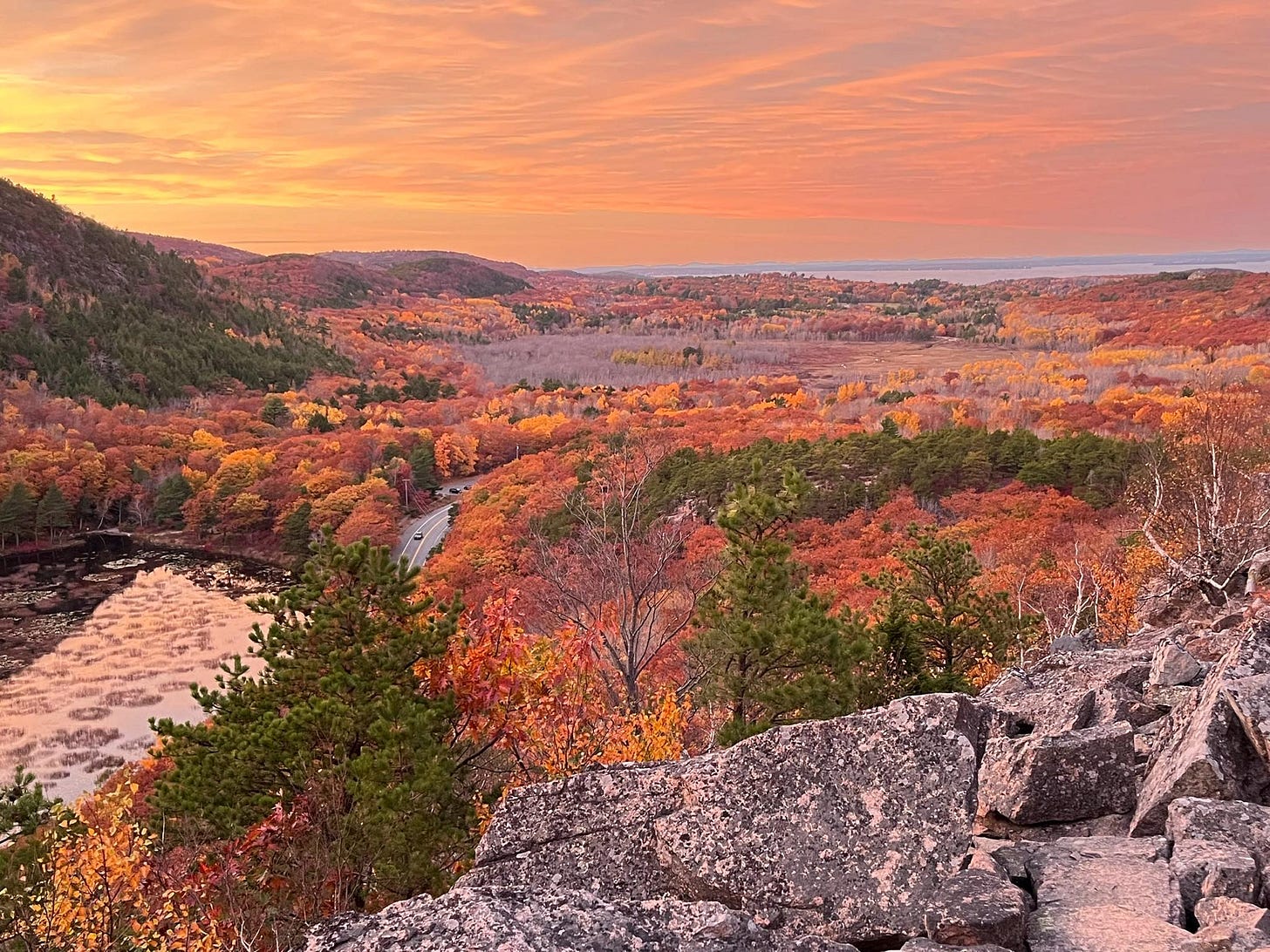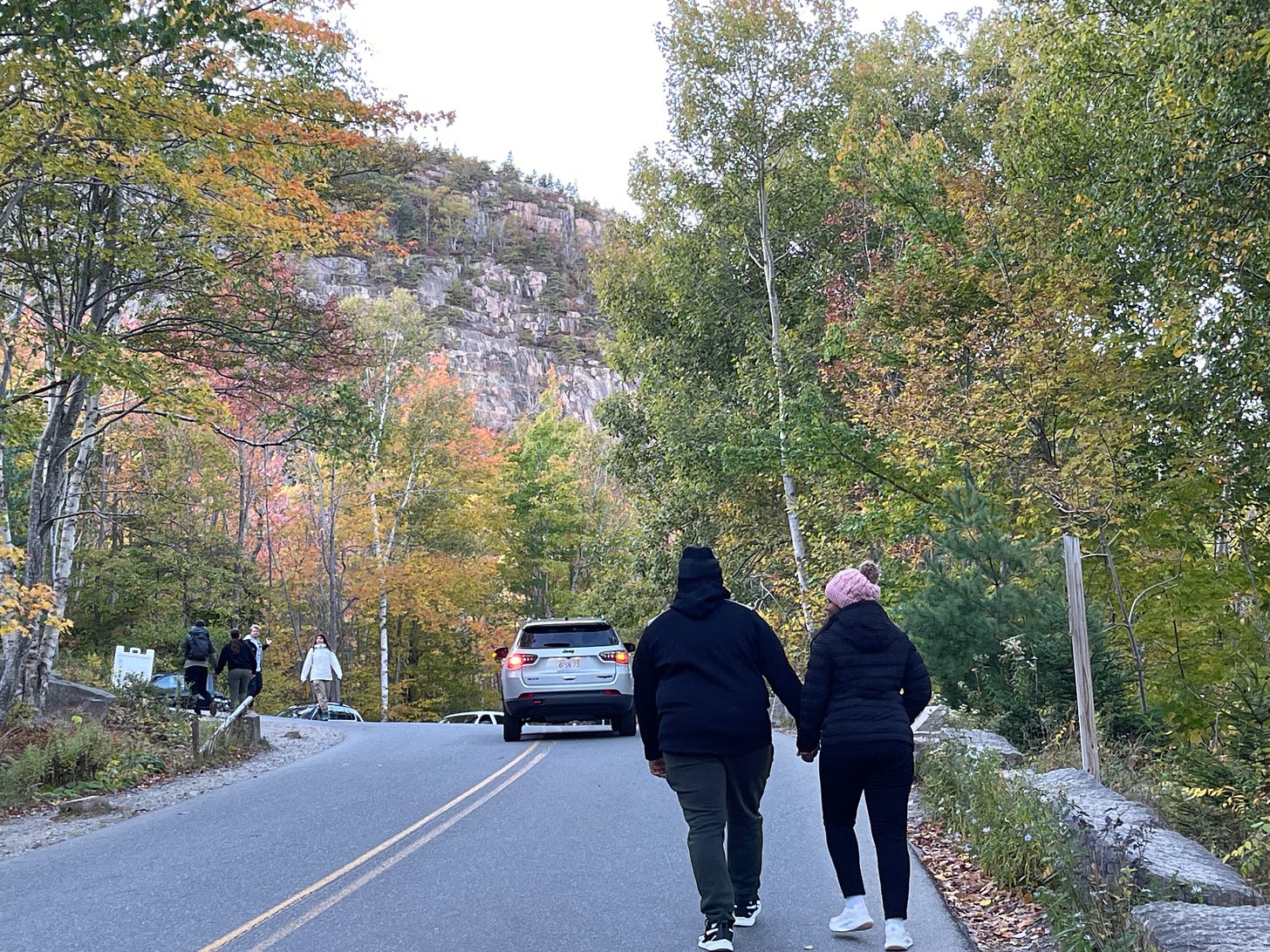The Bar Harbor Story is generously sponsored by Gary Friedmann for State Representative.
ACADIA NATIONAL PARK—The record-breaking number for visits at Acadia National Park on the October 12 holiday weekend are more than just numbers, according to the park’s Public Affairs Officer Amanda Pollock.
They have nuance.
They have impact.
And they tell a story.
That story is currently leaning toward an expanding season for a park that typically sees most of its visitation in the summer months. That story is also leaning toward challenges in how to provide a great experience for people visiting the park while protecting the park’s resources when it’s a park that has many elements that are not winterized and has labor shortages and housing needs for workers who do choose to come to Mount Desert Island.
The previous peak daily visitation record had been July 3, 2022, and it was 3,561 vehicles going through the Sand Beach entrance station at the head of Ocean Drive.
That record was crushed on October 13 with 3,636 vehicles going through the station.

On Sunday of Indigenous People’s weekend, 1,953 people hiked the Beehive Trail. And in between 9 a.m. and 10 a.m., ANP Social Scientist Dr. Adam Gibson counted 279 on that trail. The Precipice hosted 816 hikers on Sunday.
“This is October. That’s really unusual,” Dr. Gibson said Tuesday.
It’s part of a trend the park has been seeing in increased visitation in the shoulder seasons. Fall has had increasing visitation for the last ten years, he said.
“Spring is more fickle,” he said.

The Beehive was also the site of one of the five search and rescue operations that took place in the park during the weekend. There were 35 law enforcement and emergency incidents during the four-day weekend and just over 60 for the entire week.
THE NUANCE
Understanding the nuance behind the numbers and the implications of changing behaviors is Dr. Gibson’s job. Even the weather can influence how people visit and use the park. That Saturday was windy. More people spent time in cars rather than hiking the trails, Dr. Gibson said. On Sunday, that changed. People left the cars, parked them more efficiently, and headed to the trails.
“It provides some interesting management implications,” Dr. Gibson said. “Even when you can predict use levels, you can’t necessarily predict the conditions.”
Dr. Gibson spent his weekend counting, getting data, observing. And part of what he and Pollock emphasized was that though there were 3,636 vehicles that went through the Sand Beach entrance station on Sunday and a very similar number on Saturday, the situations caused very different experiences.
On Saturday, the park closed down the Sand Beach entrance station from 2 p.m. to 3:30. During that time, no vehicles were allowed into the road.
Vehicles were parked extremely close to the station and all along the right-hand side of Ocean Drive, making it difficult for people to maneuver. Despite that closure, over 3,000 vehicles still went through the gates that day.
On Saturday, an Island Explorer bus reported that it was at the Precipice Trailhead at 12:49 and didn’t get to the Fabbri picnic area until about 2 p.m. Normally, that stretch of road takes the bus approximately 30 minutes.
The Island Explorer also had its third highest ridership numbers that weekend with 9,745 rides. The highest was 10,685 in 2018. The total ridership numbers for the system was 10% higher than 2023 at close to 500,000 rides. This still doesn’t hit its highest ridership numbers (648,105) set before the pandemic.
The fare-free, propane-powered bus system that carries people around Acadia National Park and area communities had its 10 millionth passenger September 25.
Half the visitors to the park are first time visitors, Pollock said.
At the town of Bar Harbor’s safety meeting on Tuesday night, October 29, ANP Management Assistant John Kelly said that a barrier to safer roadways in the Bar Harbor and Mount Desert Island region is that a new cadre of park users come every season.
At that same meeting, Downeast Transportation’s Paul Murphy gave the Island Explorer some credit in reducing some of that traffic, but also being involved in some fender-benders. At that meeting, there was discussion about a potential correlation between a lower amount of fatal or serious injury accidents in high-congestion, but low-speed areas.
THE CADILLAC EXPERIENCE
The experience on Cadillac Mountain was much more controlled and a lot different than the experience on Ocean Drive that weekend, Pollock said. That’s because the 3.5 mile road to the peak allows the park to have a reservation system. That system was piloted in 2020 and implemented in 2021.
Prior to the system, she said, people would abandon their vehicles in the road when they couldn’t get parking. At busy times, drivers would park on sidewalks and in the vegetation where the cars would damage it.
Since the reservation system was implemented, more people have hiked the mountain, Dr. Gibson said.
Typically, people in vehicles spend about 30 minutes on top of the mountain. It’s longer on foggy days. The parking capacity is 1,500 and there’s been consistently less than that visiting via cars. Dr. Gibson estimated that if there was not a reservation system, based on past numbers and the Sand Beach entrance numbers this year, there would have been almost 3,000 cars trying to visit the peak on October 13.
A recreation technician coordinator at Friends of Acadia, Becca Stanley’s graduate thesis is focused on whether or not the Cadillac reservation system is successful. Dr. Gibson and Pollock believe it is.
“It allows people to plan,” Dr. Gibson said. It’s the one place in Acadia where you are guaranteed a parking space—if you have a reservation.
Between June and August 2021, Stanley surveyed visitors on the Cadillac Mountain summit.
“In 2021, 53 percent of respondents were first-time visitors to Cadillac Mountain, and 66 percent had never been in a U.S. National Park managed access system (reservation system) prior to their visit,” she wrote. “From the respondents’ sources of information, the study revealed that 26 percent purchased their permits one to two months before their visit, while nearly 60 percent purchased within 48 hours of their visit. Among those who purchased permits, 58 percent did not encounter any issues, while the remaining 42 percent mentioned that their first-choice time slot or day was unavailable, faced limited cellular connectivity, or other issues.”
Some expressed displeasure at not being able to secure their first-choice reservation time.

Every year, there are approximately 4 million visits to Acadia. This makes it one of the nation’s most popular parks.
“This popularity is a bit of a double-edged sword: it’s wonderful to share the park with so many visitors, but a challenge to effectively manage park ecosystems while maintaining high-quality visitor experiences,” Stanley wrote for Friends of Acadia
The park’s 2019 Transportation Management Plan details hopes that the Acadia Gateway Center in Trenton and the Island Explorer shuttle system will help decrease the amount of vehicles in the park. There are also preliminary plans to potentially create reservation systems at Jordan Pond House and the Bass Harbor Head Lighthouse, both places are heavily visited and have issues with vehicular congestion.
The extended fall season creates concern because of seasonal employees cycling off and because a lot of the park’s infrastructure is meant to be seasonal as well.
Cadillac Mountain’s reservation system ended on Sunday, and Dr. Gibson was out on Monday counting the numbers at sunrise. And what he found?
He counted more people than have been there for sunrise all year.
More than that though, there were 25 vehicles in undesignated spots. There were 16 in the bus lane. The bathrooms were closed, so the summit had the most people it had all season sustained by two port-o-potties.
“It’s a challenge,” Pollock said.
Pollock said that they know what they want experiences to be like and they know they want to protect the park’s resources. The challenge becomes part of the story and part of the numbers: how to take care of a park in a way that will keep it wonderful.
“Visitor behavior is changing; we’re seeing a lot more humans,” Pollock said.
There’s nuance there still, she said. A number doesn’t tell the whole story, but it’s an important piece in a bigger story, and that story involves, sociology, visitation patterns, psychology, climate change, weather. The park’s goals haven’t changed even as it becomes more popular.
As Stanley wrote, “This popularity is a bit of a double-edged sword: it’s wonderful to share the park with so many visitors, but a challenge to effectively manage park ecosystems while maintaining high-quality visitor experiences.”
Updates: We’ve updated this story with an additional photo and corrected an inaccurate label. My apologies! My broken body hasn’t been up the Precipice for a few years and I mislabeled the view from the back of Champlain as the view from the Precipice side. The error is completely mine! Many thanks to the reader who noticed and who has been up the trail much more recently than I have!
If you’d like to donate to help support us, you can, but no pressure! Just click here.
If you’d like to sponsor the Bar Harbor Story, you can! Learn more here.













The persons not identified standing with Adam Gibson are Becca Stanley, FOA Recreation Technician Coordinator, and Ella Skolfield, Recreation Technician, on the right. They play a very important role in managing the crush of visitors.
We attempted to drive through the Park that week-end. Even entering from Schooner Head, the drive was looong and slooow. The feeling you get along Ocean Drive nowadays is, "by the time we got to Woodstock, we were half a million strong..." By the time we got to the Fabbri Memorial, it was enough. After that we stuck to the backside of the Island. Makes me feel bad for all the people who drove from the West Coast and Southwest (judging by their license plates). All of the parks are overwhelmed. We are loving them to death.